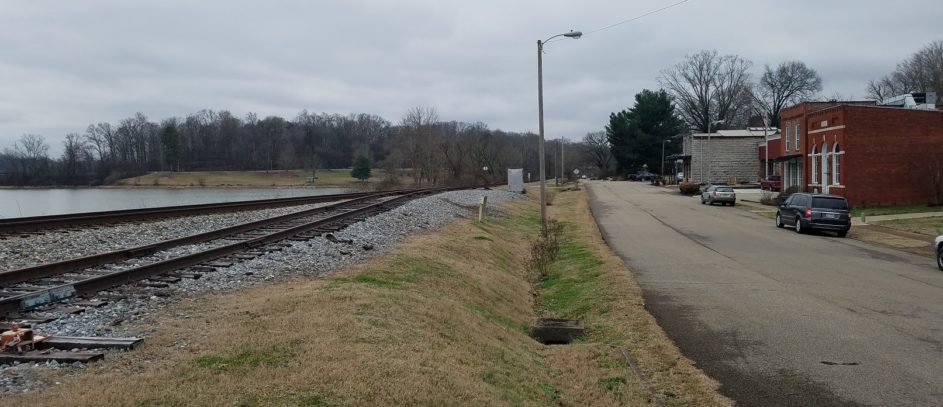The handsome older buildings on Lake Ridge Drive, in the historic village of Concord, give lie to the idea that everything in West Knoxville is new, new, new. The red-brick building that houses an art gallery – once a bank, later a grocery store – was built in 1910. A gracious limestone building nearby had its first incarnation in 1890. Gazing at the orderly tableau, you could be in any charming historic downtown.
But on the other side of the street, where you might expect a business district to continue, a railway rises on a ridge, truncating the town. Beyond the tracks are the waters of Fort Loudoun Lake. In the early 1940s, the Tennessee Valley Authority impounded the land beneath those waters for a reservoir that would connect to the Tennessee River, following the construction of the dam at Fort Loudoun. Concord had to move its train depot, relocate its railroad tracks, give up some of its business district and lose homes and farms.

Concord, on what’s now Lake Ridge Drive, looking west to the old bank building (then Irwin’s Grocery), from a collection of TVA photographs taken in 1942, before the area beyond the tracks was flooded. (Photo from the National Archives and Records Administration)
After some initial fear that its railway would be lost, and with a couple of families opposed, there was little reported fuss in Concord when the waters came. It may have been that the federal government caught the village at a good time: Growth had been stalled since the Great Depression.
Before that, Concord had been magically prosperous. Construction of a rail track began in 1853. James Rodgers, whose family settled in the area in the late 1700s, platted and sold the land in the original village in 1855 before heading west after the Civil War, along with three of his five brothers. (One who stayed, S.A. Rodgers, became a prominent judge.) A Masonic Lodge was established in 1856 – a sure sign of civilization – and the lodge building, standing atop Second Street, was built in the 1870s. Even the Civil War, which divided the village as much as it did most places in East Tennessee, couldn’t slow growth. A booming marble industry took Concord through the 1880s into the 20th century and right up to the crash of 1929.

From the vantage point of present-day Concord Park, a shot from the early 1900s of the village of Concord, with the Masonic Lodge visible through the trees at the top of the hill. (Photo courtesy of the McClung Collection)
Across the lake, you can see the structures of the county’s Concord Park, the shelters, the private restaurant, the marina. The creation of a 400-acre public recreation area was promised when TVA impounded the land, and although World War II slowed the construction of amenities, and the offerings of the original park have changed, TVA came through with its promise in the late 1940s, leasing the land back to the county for a token fee.
Winding back through the quiet streets of Concord, spying homes from 1875, 1910, 1920, passing historic churches and the old cemetery, it’s tempting to think of the village as a time capsule. Seeing the busy roads that have grown up around it, and the development that continues to encroach, it’s not possible to think it will stay that way.

